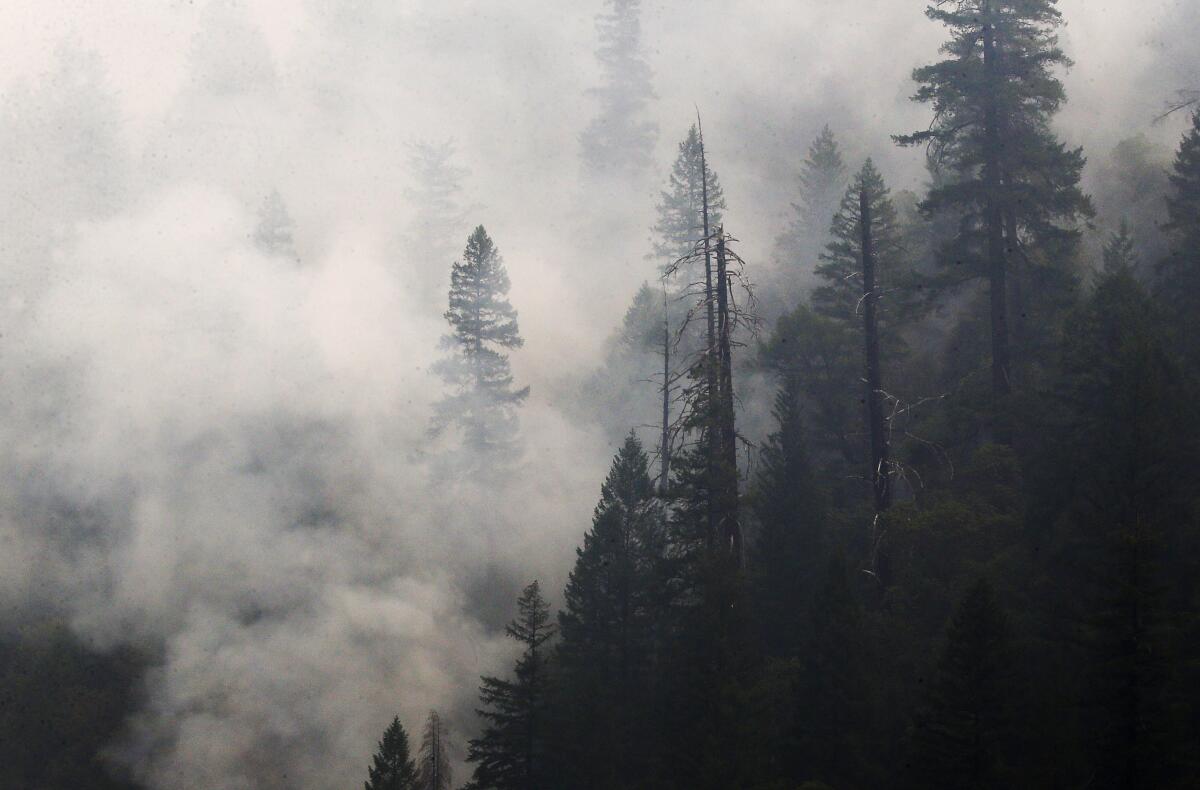Firefighters notch some containment on 57,000-acre McKinney fire for the first time

- Share via
Rain allowed firefighters to ramp up their efforts on the massive McKinney fire, which is now 10% contained, officials said during a community meeting Wednesday in Fort Jones, Calif.
The blaze, which has charred 57,519 acres, continued to burn slowly in Siskiyou County as authorities lifted some evacuation orders. Four bodies have been found in its path.
The Yeti Complex and Alex fires burning nearby were listed at 2,986 acres and 151 acres, respectively, according to the Klamath National Forest. Both were 0% contained.
Ten evacuation zones — seven in Yreka and three in the county — have been downgraded to warnings, officials said Wednesday night. The affected areas are primarily in Yreka from Fairchild Street and Shasta Avenue west to the edge of the residential district.
Residents in those zones can return to their homes, but authorities stressed caution and warned that anyone in the area should still be prepared to leave if warnings change to orders.
Officials referred residents to community.zonehaven.com for up-to-date information on evacuation orders and warnings.
Phil Anzo, a unit chief with the California Department of Forestry and Fire Protection, said the recent rainfall allowed crews to go up to the fire’s edge and build containment lines, but he emphasized that the work is far from over.
“When you look at this fire on this map … it is massive and there’s still a lot of work that needs to be done,” Anzo said.
A deadly combination of intense heat, parched vegetation and dry conditions has turned the 55,000-acre McKinney fire in the Klamath National Forest into its own force of nature. The culprit: human-caused climate change.
Though the rain tamped down portions of the fire, it created some challenges for firefighters, said Dennis Burns, a fire behavior analyst with California Interagency Incident Management Team 2.
Matt Conklin, an operations section chief also with Team 2, noted the rain produced some debris flows in the Humbug Creek area that caused delays as crews cleaned up.
And after years of drought, fuels have dried so much that the rain did little other than temporarily slow the fire, Burns said.
Some fuels in the burn area are sitting at 4% to 6% moisture, he said, compared with the typical 11% moisture of kiln-dried wood purchased from a lumber yard.
“Even though we got this rain, those heavier fuels, that rain had no effect on it whatsoever,” Burns said. “All it did was it took the flames away from it. We would have been better off to have 1 inch of rain over three days than the 3 inches of rain that we got in one hour yesterday.”
The rain did pause the fire, allowing firefighters to move in close, but in some areas, the precipitation made the situation worse by putting out fire on fuels that would otherwise have been completely consumed, leaving them ready to reignite, he said.
Rainfall over the fire was inconsistent, with the majority of the burn area getting less than a tenth of an inch, Burns said.
Nevertheless, firefighters have been taking advantage of the pause in extreme fire behavior, he said. With hotter, drier weather over the coming days, crews will be able to test existing containment lines against conditions.
Though the blaze will continue to put out smoke, fire officials believe there shouldn’t be any large runs in the next three to four days, Burns said.
Darryl Laws, a unified incident commander with Cal Fire, echoed the assessment, calling the McKinney fire “a sleeping giant.”
Laws and other officials urged all residents, including those allowed to return to their homes, to be on alert and ready to evacuate if needed.
“When people don’t heed those orders and they call 911 … that takes us away from being able to put out the fire,” he said. “The best way to protect your homes is for us to get out there and put out that fire.”
More to Read
Sign up for Essential California
The most important California stories and recommendations in your inbox every morning.
You may occasionally receive promotional content from the Los Angeles Times.













